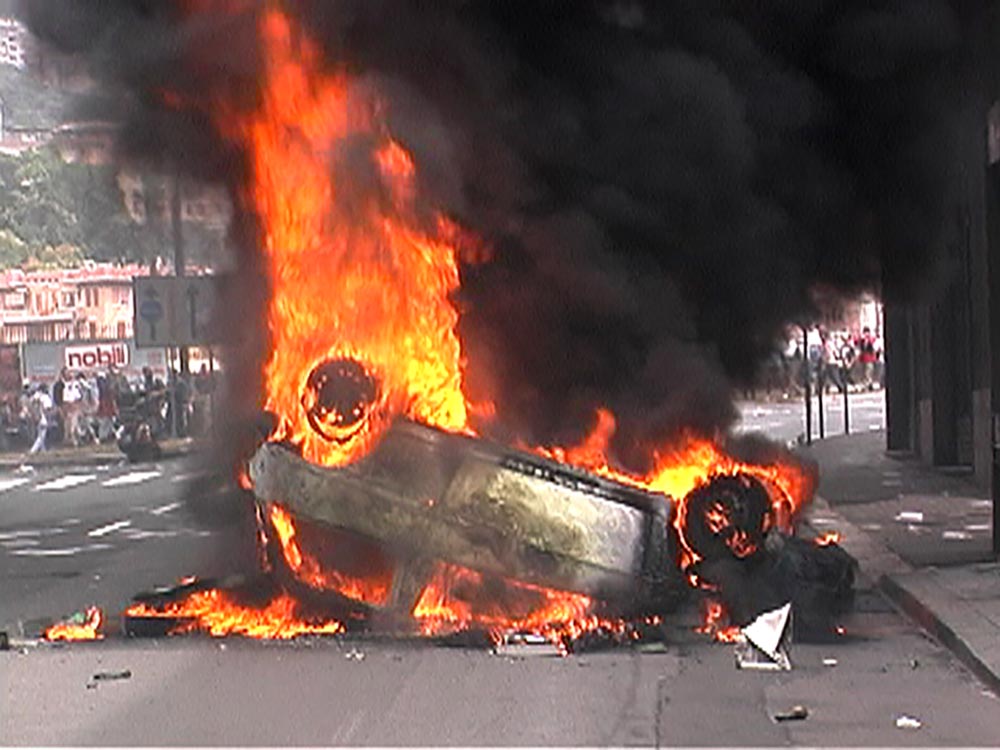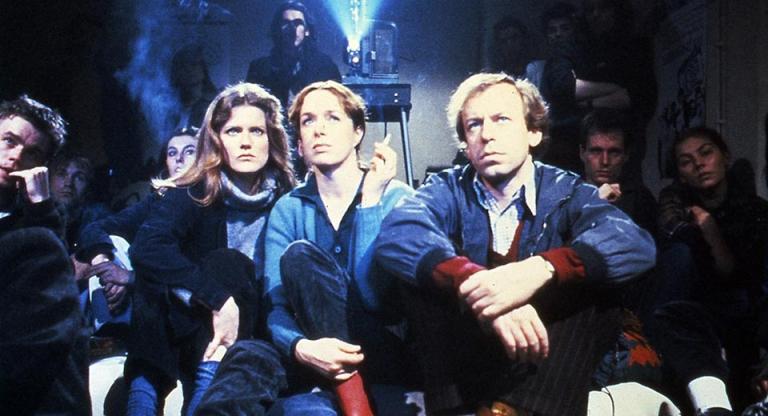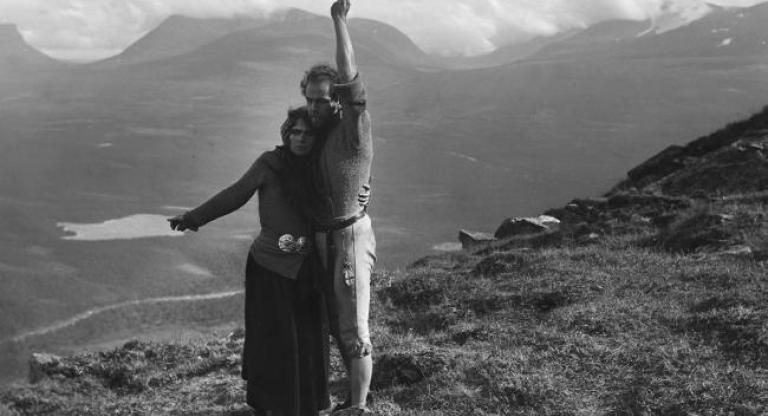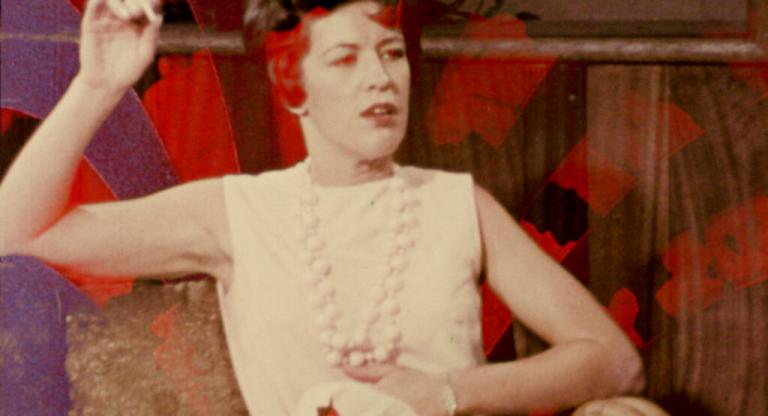I first saw Bernadette Corporation’s Get Rid of Yourself (2003) in April 2011 as part of a program of collectively made films that was presented at a former-bodega-turned-microcinema near the foot of the Williamsburg Bridge by a group that called itself Red Channels. Someone from Red Channels must have had access to CUNY Hunter’s campus, because I came across a poster announcing the program thumbtacked to a corkboard in the North Building. The five-day program was extensive and included films by Chto Delat and the Black Audio Film Collective, as well as a bunch of “Cinétracts” made semi-anonymously by various French New Wave figures. This is the context in which I saw Get Rid of Yourself—flanked by footage from Japanese university occupations, newsreels of Depression-era mass demonstrations, and the hugely-fetishized imagery of May ‘68. It was a master class in aestheticizing the riot.
Because of this context, I overlooked many aspects of Get Rid of Yourself. For example, Bernadette Corporation’s background of culture jamming the fashion world with faux Ralph Lauren ads and satirical novels about supermodels is present in the film, but these references are easily missed if you’re fixated on the Genoa black bloc’s dumpster barricades. How do these facets of their work relate to each other? Late last year, I “sat down” with the collective and got some answers.
Get Rid of Yourself and Hell Frozen Over (2000) were originally due to show at Metrograph in December as part of the 50th anniversary celebration of media art distribution nonprofit Electronic Arts Intermix. Postponed due to COVID, the screening now takes place Saturday, February 12.
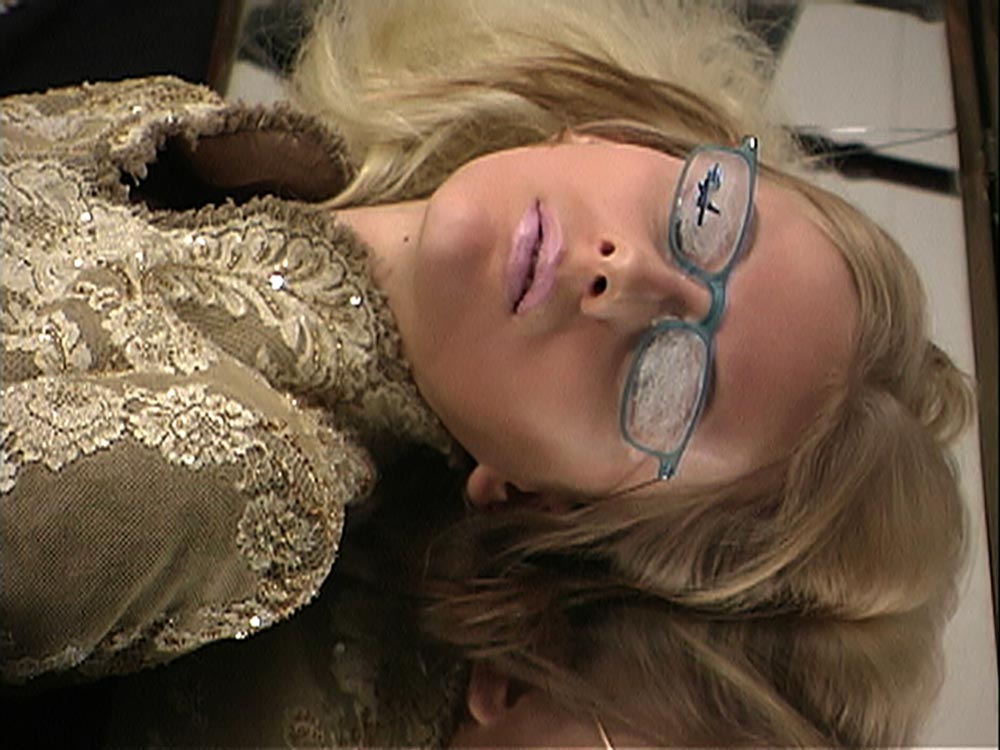
Cosmo Bjorkenheim: Rewatching Get Rid of Yourself and watching Hell Frozen Over for the first time, I can’t help but wonder why you were all such Francophiles at the time?
Bernadette Corporation: BC was semi-based in Paris during the editing of Get Rid. Paris and New York seemed more connected then than they are today. Paris things were a part of the conversation in NY too. For example Semiotext(e) was a bridge between Paris and NY, so was Purple magazine, which BC worked a lot with when it was a fashion brand. Also we were into cinema and so much of film culture at the time was centered in France.
CB: Why are Paris and New York less connected now? What even is an ”art capital” anymore? I look at things like Art Basel Miami and it's just NFT bros.
BC: True. These cities used to be in conversation because the differences between us were more specific. In Get Rid, the word “metropolis” was a way of signaling the end of cities as specific worlds.
CB: In Hell Frozen Over you were a little more focused on fashion and less focused on Tiqqun. How did that shift occur?
BC: Bernadette Corporation started out, circa 1994, by trying to be the fashion brand equivalent to [Malcolm] McLaren’s Sex Pistols experiment. In 1998, we internally split and ended the fashion label. So what followed was a membership and direction shake up. But it was still our habit and our profile to work out of fashion, so we continued keeping one foot in it, for a while, while going different ways with the other foot.
Hell Frozen Over was commissioned for a mega exhibition at the Walker Art Center in Minneapolis. The fashion parts were filmed during a photo shoot that was the other component of our art work for the exhibition. The Sylvère [Lotringer] parts happened spontaneously when we went to visit him for New Year's. He delivered this unscripted, unrehearsed, impromptu talk on Stéphane Mallarmé while standing out on a frozen lake, recorded in a single take. Earlier he had introduced us to the pseudonymous fashion writings of Mallarmé, which we translated and published in our magazine Made in USA. Made in USA was a "fashion magazine" and an experiment with that form, only three issues. Sylvère also gave us an interview with Paul Virilio for the third and last issue. I think it was called "The End of America"? I don't know if fashion was more of a focus or more of a medium that BC operated within, fashion rather than art. Some kind of dream of working within a mainstream channel, and the creative possibilities of that.
CB: In the frozen lake footage there's someone speaking Swedish or Norwegian, which adds to the geographical ambiguity. Where is that lake?
BC: Yes, that sound was added later during the edit. We recorded some students visiting from Scandinavia. The lake is upstate in the Adirondacks.

CB: Now that we have almost twenty years of historical distance from the Tiqqunist language of Get Rid, what aspects of it remain relevant and what aspects have become less relevant?
BC: Tiqqun's language and tone might seem ancient now, I mean they already did at the time—a bit priestly and modern-philosophical—way before Twitter etcetera. But I still hear that line in my head today: "The counter-revolution, too, was micropolitical." It's striking maybe how unconscious we all were to what was coming on the tech front, and how quickly this would change the city.
Tiqqun really saw the willingness and desire on the part of citizen-consumers to enter a flattened, algorithmically reordered world. They called it "bloomification" and "jeune-fille.” They saw it coming, the "desert spreading"—a poetic hallucination of this. And it's happened. But maybe they underestimated how massively and quickly the shift would come? I don't remember anyone saying "accelerationism" then. And of course they couldn't imagine the resistant and creative life-forms that might then emerge in this desert, beyond the old idea of organizing communes, an idea that already felt ancient then. They referred to heretical early Christian sects.
Get Rid was shot right before 9/11 and edited right afterwards, as the Patriot Act and cyber-surveillance were going into effect. So in a way, it captures a bit of the disorientation of the time, how quickly social and political life was secured following 9/11.
CB: Was Get Rid the first art piece to use 9/11 images purely for their aesthetic value?
BC: I don't know if they're purely aesthetic? At the time the video was made, those images were borderline unwatchable, because they were so felt and so traumatic. I think they are hugely aesthetic but not purely aesthetic. Same with Genoa footage. I guess that's how the film works: to make things "aesthetic" doesn't neutralize them entirely, only partly or provisionally, in order to make them say and do something else in combination with other images and sounds—fashion, beach scenes, etcetera. Those shots were filmed from our rooftop in Williamsburg.
CB: I guess your use of those shots doesn't feel purely aesthetic, but the way you mirror them and flip them makes it feel like you're playing with them. Since you don't do that with any other images it really stands out.
BC: I think a lot of the Genoa protest footage was fucked with too, digitally, in the edit. Many effects, filters, and sounds were involved, in a crude way. There was an impulse to make the images speak differently, maybe by fucking with the ways that they’re already so culturally overcoded.
CB: Sylvère calls Mallarmé a “syntax maker.” Do you consider yourselves syntax makers?
BC: Yes sure.
CB: I ask because in a certain way it felt like with Get Rid you were creating a new syntax for this kind of political treatise movie: the cryptic and kind of "ancient" language of the Tiqqun texts read over riot porn and shots of the bloomified subjects of Empire bumbling around, etcetera. I feel like this is a form you invented.
BC: We came back from Genoa with all this kind of boring footage of the anti-global protest and its disruption by the black bloc element. There was an idea to do something black bloc-like with the footage itself. At that time, the black bloc was anti-media, anti-representation, and rioters would systematically attack TV journalists in the street, smash their cameras. It was about not being captured by the cameras, creating a “zone of opacity.” The question was how to make the film without simply smashing and blacking out the images? That’s maybe where Get Rid’s weird syntax comes from. A sort of riot poetics that didn’t want to simply negate the image, or not in the usual way. It was weird after Genoa how quickly social media became embedded in the protest, starting with Occupy. And then police body cams, drones, etcetera. There’s a long black-screen moment in Get Rid that kind of underlines this idea, the Situationist gesture of the empty screen or image-less film, but in Get Rid the blacked-out screen becomes just another image.
CB: Why so many explicit Godard references? The voiceovers in French, the costumed guy in the woods, Chloë’s monologues, the disruptive titles, the burning beach umbrella, the use of fragmented classical music, the mismatch of image and sound . . . I cared about Godard then too, but in retrospect I just can’t figure out why we were all like, “Here’s a guy we love to hate to love.”
BC: True. I remember shortly after Get Rid, not being able to watch or think about Godard for the next 10-15 years. But recently I've been thinking about him again. He just turned 90. His last three films are all pretty great, formally extreme, like noise music. Also, many of the people we made Get Rid with were French, or spoke French more than they did English.

CB: Do you think in retrospect that Get Rid and late Godard are cut from the same cloth?
BC: At the time of Get Rid, "post-cinema" was an idea. Godard, with his video work and the way he made the "scenario" for a film as a film, was involved with that idea too. Cinema at the edge of the digital. New kinds of screens—touch-screens, screens for writing. There’s also a tendency toward something like the “discrepant image” of Isidore Isou’s Traité de bave et d'éternité [1951].
CB: You have a ton of references to the ’60s, some critical, some ambivalent: the Doors, the White Album, Cat Stevens, Ton Steine Scherben, “If it weren’t for me, you wouldn’t have this wonderful protest culture” . . . Is it trite to say that this is your j’accuse against the boomers? But you love the Italian Autonomists, and they were boomers too. Explain!
BC: Lately everything gets parsed too easily and efficiently in generational terms. It's such a go-to way of understanding history and change. This is a way of thinking that's become more dominant with social media, no? Generations being named in terms of generations of tech, which platforms and devices the kids are on now. I remember the "Younger than Jesus" show at the New Museum, thinking, Oh ok, so now art is about exactly how old we are, and these shows want to nail down a relevant generation, like real estate, and produce value. But some might argue the differences within a generation—all the people on earth that were born at the same time—can be much greater than differences between so-called generations. There's also Nietzsche's idea of the untimely. There were plenty of “boomers” in the black bloc too. J’accuse myself!?
CB: Nietzsche's untimely is a good concept for describing Tiqqun's hieratic language; they use it to fish around for other people who feel that aspects of the buried past are calling out to them. Do you think it's an effective approach?
BC: Yes and maybe hearing the corny Doors guitar solo—rather than hardcore punk—over black bloc rioters creates a sort of Benjaminian dialectical image moment, causes a kind of slippage of the image within its own historical coordinates. It also makes the riot suddenly uncool and funny, a “riot” again. I think there’s also an idea of betraying the image, which comes from the black bloc and is then applied to the image of the black bloc too. Instead of simply blacking out the image.
CB: I love the vacation footage in Get Rid, so sad and lonely and banal. Where was it shot?
BC: Calabria, right after the Genoa anti-global thing. Sudden post-riot doldrums, lying around doing nothing.
CB: Why did Genoa ’01 feel like such a flash point for you at the time? How did you feel that it related to 9/11?
BC: We stumbled into Genoa not knowing what would happen there. A lot of the momentum around Genoa and the anti-global movements was squashed after 9/11.
CB: There’s a voiceover in Get Rid of someone talking about the early Christian monks, the monakhoi, and their “offensive retreat” into the desert. Have either of you ever felt like those monks? Retreating from the stupidity of the world the better to attack it?
BC: Honestly I never tried the commune life. I think "offensive retreat" maybe comes from T.E. Lawrence? Nowadays retreat is a part of every entrepreneur's daily routine, the half hour of meditation before killing it in the home-office. Maybe, in a way, distance is helpful, but in order to just be able to better figure out one’s own position and possibility within it.
CB: I love The B.C. Corporate Story (1996). There’s an insane clip of a white NYPD officer dancing to Snoop Dogg and a Black guy snapping the cop’s neck. Where did you find that?
BC: We did that ourselves. We made our own fashion campaign, for our 1996 collection, and based it on the TV show Cops. It was the way that the then-WASPy brands, like say Polo, got appropriated by not-at-all-WASPy people, and the kind of negative advertising it would get on Cops. Someone would be getting arrested and right up against the camera would be the Polo logo. So we recreated such scenarios with our logo. It’s the privileged Polo program, which is then put to a different use by the public.
CB: I would love to see more from that campaign. Where can I see it?
BC: Here are two spreads from our fashion campaign after Cops.
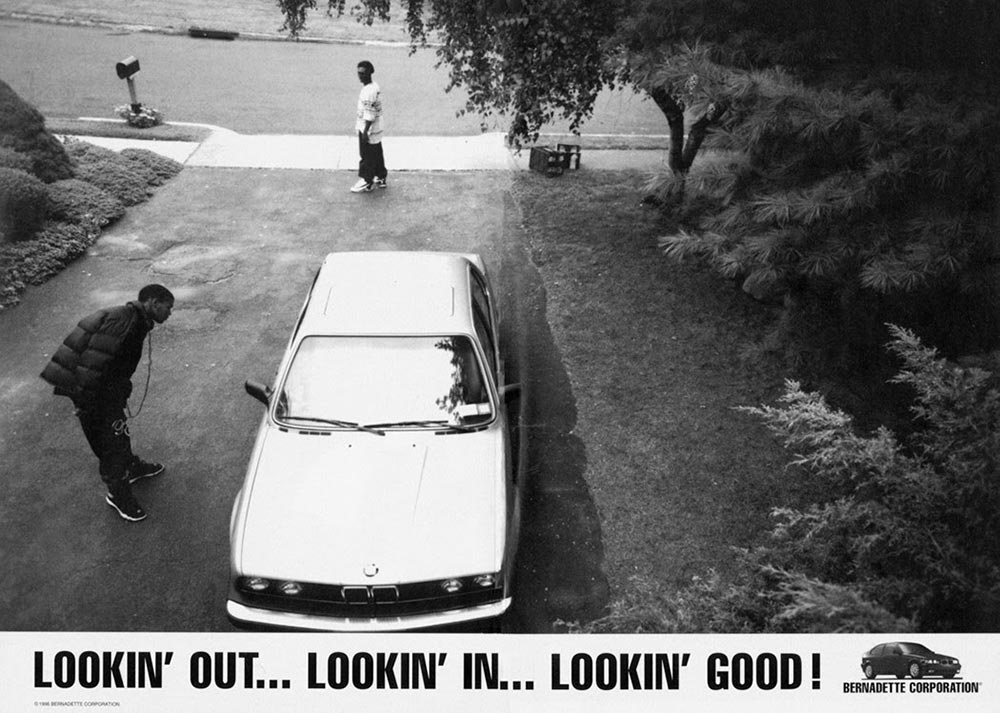
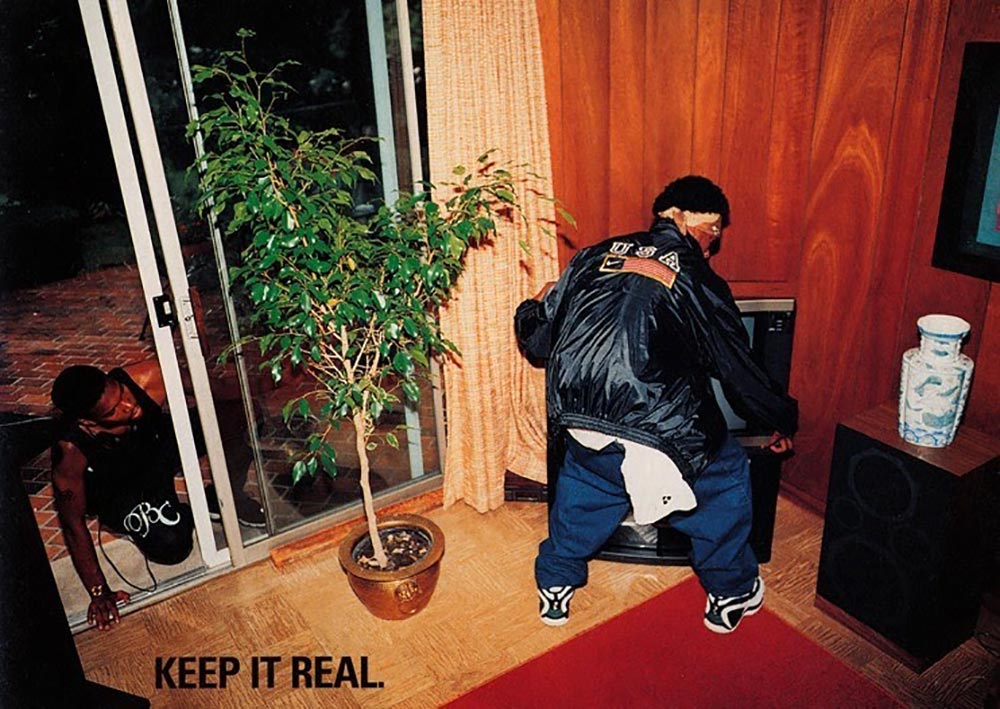
CB: Do you think you played a role in making black bloc aesthetics cool and digestible for fashion?
BC: This would happen anyway. Kim Kardashian's outfit at the Met Gala: full black bloc.
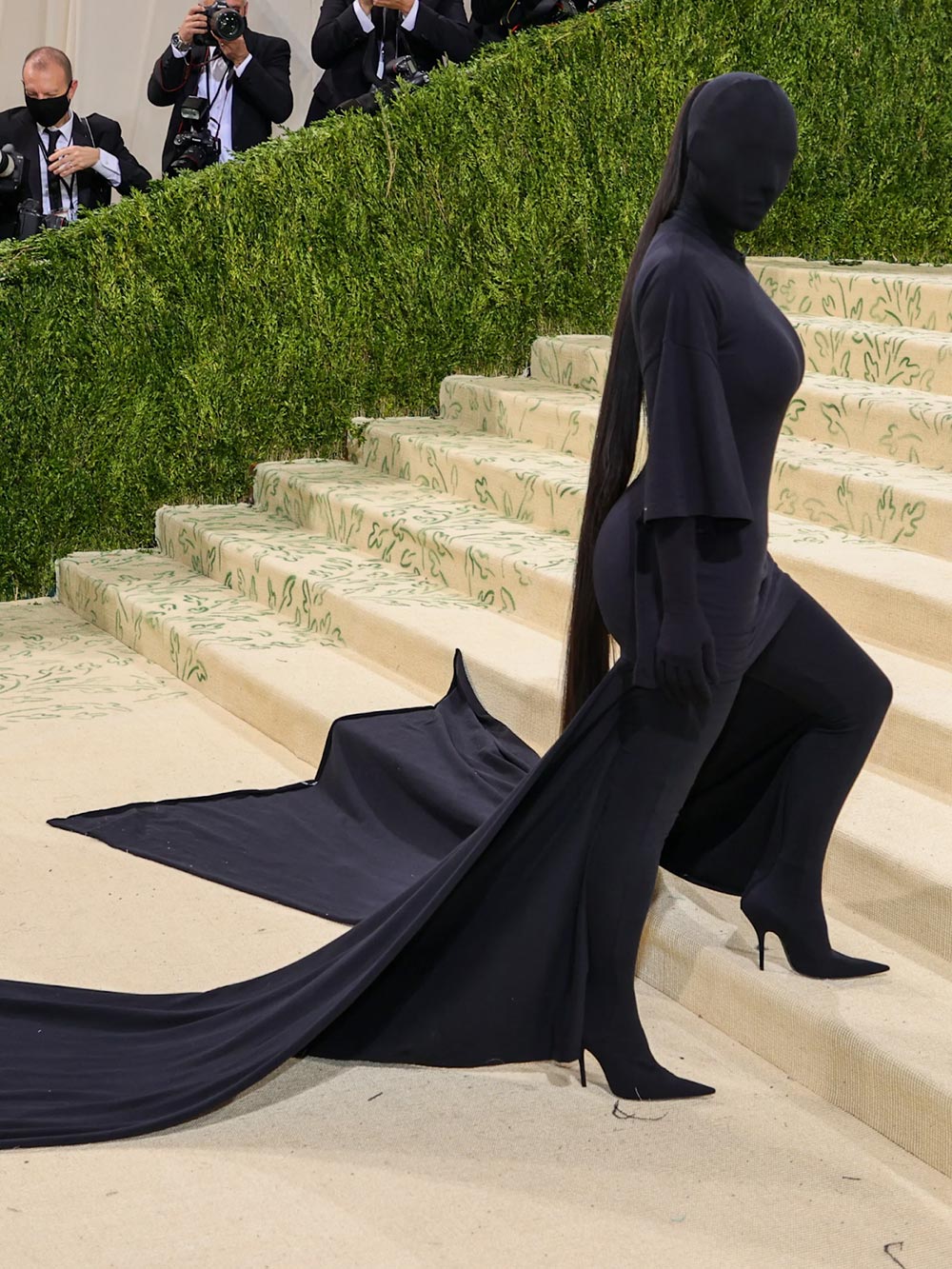
Hell Frozen Over and Get Rid of Yourself screen February 12 at Metrograph.
